Continental Attack & Force
I’ve always been a fan of tough-sounding product names. I don’t know if it actually influences our buying decisions, but I have to give credit to the marketing departments and copywriters for trying. Continental really went for it with their Attack/Force tire combination. Are we supposed to ‘use the force’ to make an attack on the peloton? Sure, why not?
The rest of the Continental line-up has a handful of curious names. Or rather, names that don’t always tell you much about the product. There’s the long-standing Grand Prix 4000. Then there’s the seemingly endless number of iterations of that tire – 4000 ‘S’, 4-Season, Classic, GT, Triathlon, tubular, and so on. You may read that sentence and wonder – like a double rainbow – what does it mean?
This article is my test-and-review of the Attack/Force tire set, along with an attempt to clear the muddy waters of the entire Continental tire line. The extra bonus is a look at Continental’s new Revo tire sealant.
Attack!
Continental’s agency for marketing in the US also happens to handle Easton Cycling (among other things). They sent me a set of EC70 SL wheels, along with these Continental tires, to test out. We reviewed the wheels separately HERE.
Here’s the whole tire kit:

What you see are the two tires, along with two Continental ‘Race Light’ butyl inner tubes, and a bottle of their new Revo sealant.
The Attack/Force set is rather unique in the cycling industry. Whereas most tires are sold without specific intent to be used on the front wheel or rear wheel of the bicycle, the Attack and Force are a specifically engineered pair. The Attack measures 700x22mm, and is supposed to be used on your front wheel. The Force measures 700x24mm, and is supposed to be used on your rear wheel. Why the staggered setup? Think motorcycles. Continental says that it offers superior handling and ability to ‘dive’ in to a corner. In addition, the concept is said to optimize both aerodynamics and rolling resistance. The front wheel and tire are the first part of your bike to hit incoming air, and the narrower tire theoretically optimizes this critical area. The rear wheel is largely known to be less important in the aero department, because the air that hits it is already somewhat ‘dirty’. That being the case, Continental chose to go with a fatter 24mm rear tire, to improve both comfort and rolling resistance, at the expense of a little ‘aero’.
Being the curious type, I wanted to see how this staggered width actually fleshed out. Tires are notorious for not measuring the same as the label reads. Some brands run small. Some run big. Some brands are inconsistent within their own line.
You also have some brands trying to save as much money as possible by using interchangeable parts between different sizes. For example, you often see the same width tread on a 23mm and 25mm tire – just attached to a different casing. It isn’t uncommon to see a ‘23mm’ tire that measures slightly large and a ‘25mm’ tire that measures slightly small… interesting, no?
As you can see, Continental did a good job of actually making two unique tires:
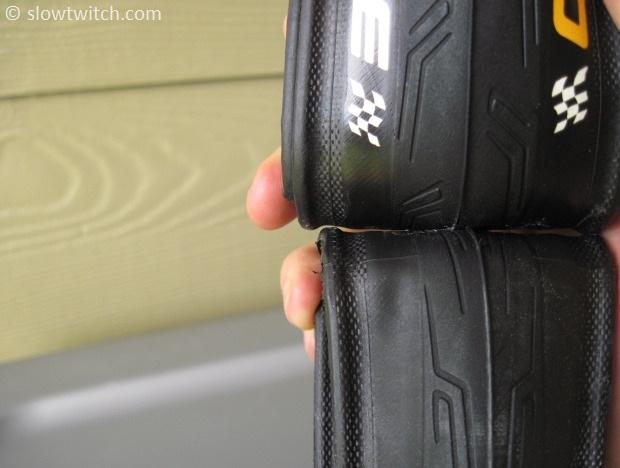
In another view:

Aside from that, it’s hard to tell much difference between the front and rear tires. The tread is slightly different. Both feature Continental’s high-tech Vectran puncture belt that gets sandwiched between the tread and casing. The real test would be actually riding the things, which we’ll address later.
Inner Tubes
Continental sent their ‘Race Light’ inner tubes to me. They’re available with several different valve lengths; I chose 60mm, to work with the 42mm deep Easton rims. You generally want about 15-20mm of extra valve sticking out of the rim for easy inflation. As a bonus, Continental tubes feature removable presta valve cores, which make for easy installation of tire sealant or valve extenders.
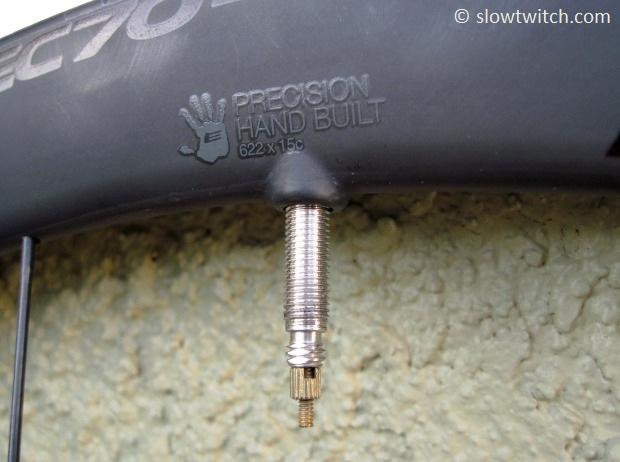
The tech geeks among you may wonder why I’d use anything but a natural latex rubber inner tube. Aren’t they faster, man? Yes, latex inner tubes do have lower rolling resistance than a synthetic butyl rubber tube. In layman’s terms, that means they require slightly less energy input from the rider to roll forward. They’re also a lot more expensive and leak air much faster than butyl, due to their more porous nature. And – more importantly, Continental does not sell them.
That wasn’t a deal breaker for me. Butyl tubes get the job done just fine. What is worth discussing, however, is that not all butyl tubes are created equal. You see, there is more than one way to manipulate rolling resistance. One way to make a tire and tube faster is to change the material. That’s what you’re doing with a latex tube; it is more elastic than butyl. When you roll down the road, the tire and tube deform as they hit the pavement. As they leave the pavement, they must return to their original shape. This requires energy, and latex simply needs less of it to do the job. Need an analogy? A bouncy ball made of latex rubber would bounce higher than one made of butyl rubber.
Another way to affect rolling resistance is to change the amount of material you’re working with. Regardless of rubber type – the less material there is, the easier it is to manipulate. A thinner tire and tube roll faster, because you have less material to deform and return-to-shape with each wheel revolution. This becomes very apparent simply by feeling different tires with your hands. A thick touring tire wants to hold its shape when not mounted to a wheel. It is difficult to twist around or bend. In contrast, a paper-thin silk racing tubular is super flexible. In a roundabout way, the road ‘feels’ this difference too. And – this explains the age-old conundrum that every bike racer faces. The fastest tire on-paper is necessarily very thin (and fragile). How fast do you want to go?
As we can see, the front tire has a rather unique tread. Thickness is what I’d call middle-of-the-road. Not super thick, not super thin.
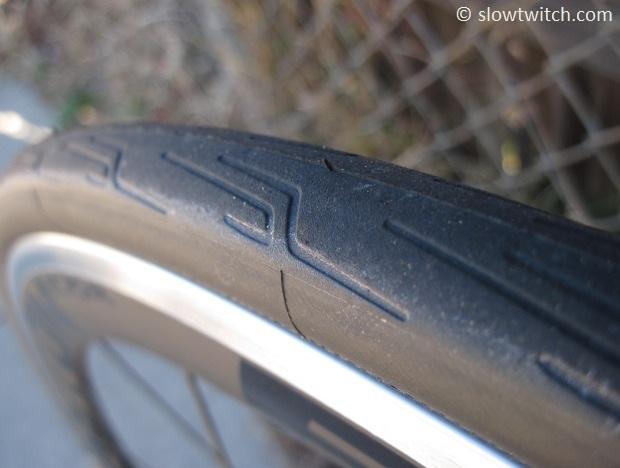
Continental has three flavors of inner tube to suit your needs. From thickest to thinnest (and least expensive to most expensive), we have the Race, Race Light, and Supersonic. Choose based on risk-aversion and budget. Interestingly, the weight of a butyl inner tube tends to follow a rough equation – about 1 gram of total weight per 0.01mm of tube wall thickness (plus or minus depending on valve length). A standard road tube tends to weigh about 100 grams, and have about 1.0mm wall thickness. The Light and Supersonic tubes weigh in at 70 and 50 grams, respectively, so we can take a fairly accurate guess at how thick they are. While a thin butyl tube still doesn’t roll quite as fast as latex, it can be a good solution for someone seeking the best of all worlds – including price.
Revo sealant
I’m a big fan of tire sealants, at least in theory. They offer a chance of flat-free performance at a minimal weight penalty. In addition, there is no definitive evidence that they increase rolling resistance. The trick is finding one that actually works.
Continental Revo is only one of two sealants on the market (that I’m aware of) that are synthetic-latex based; the other is CaffeLatex. Most other sealants are natural latex (Stan’s, Slime Pro) or glycol-based (standard Slime, Flat Attack, Bontrager SealSafe, Specialized Airlock, etc). Revo is ammonia-free, so it does not cause corrosion or rot out your tires or inner tubes. It is also claimed to contain four different sizes of clotting particles to deal with different sized punctures.
Continental has done a good job of making a bottle with a real, function cap:
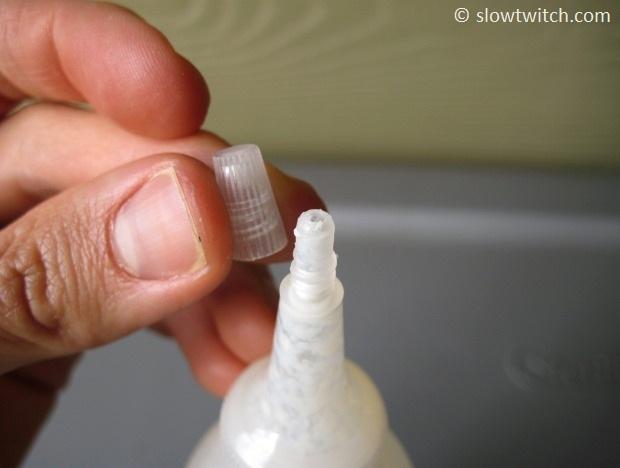
That may sound boring, but after dealing with a ton of sealants, I appreciate their effort. Many other sealants use the same spout with a little red plastic cap that tends to offer a weak hold and is prone to spills (and makes me afraid that it is speeding the evaporation of my sealant).
The cap opening is small, and fits very well on to a presta valve that has its core removed. The sealant flows through easily, which tells me that the particle size is relatively small. Smaller than, say, Stan’s. While that may sound like it would hamper the performance of the sealant, I’m not so sure. Thus far, my best performing sealant on any of my real-world punctures has been CaffeLatex, which is also synthetic-latex-based, and doesn’t have big chunks either.
Time will tell if Revo does the job. My only report so far is this: I haven’t punctured yet. I don’t have a perfectly standardized sealant torture test; for now my bikes all serve as a garage science experiment – each with a different sealant on board. The one thing I did standardize for the skinny-tire bikes is the amount of sealant – 2 oz, or 60ml per 700c tire. 650c tires get 50ml. If you have long-term experience with Revo, we would love to hear your comments (below).
Test Riding
After un-packaging all of the wheels, tires, sealant, and tubes, it was time to get rolling. I used my Effetto Mariposa sealant injector to install Revo sealant in each tube. The tires – being brand new – were a tight fit on to the Easton rims. I pumped them up to about 7 bar (102 psi).
Now that they were mounted up, it was time to double check Conti’s work on the tire width:
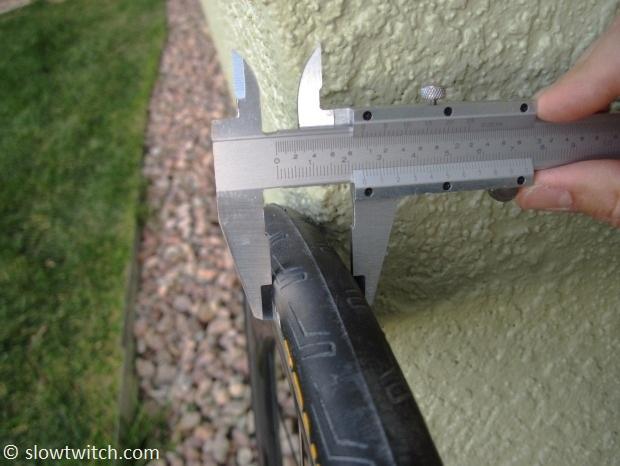
They did well. On 20mm wide Easton rims, they measured 21.9mm front and 24.1mm rear. Both figures would grow slightly on a wider rim, and shrink with a narrower rim.
Once I got to riding, I really enjoyed the tires. This is, of course, also influenced by the wheels (and I quite liked the EC70s’ ride characteristics). Despite not having latex tubes, I found the tires to ride nicely.
Here we see the rear tire tread. It is slightly different than the front.
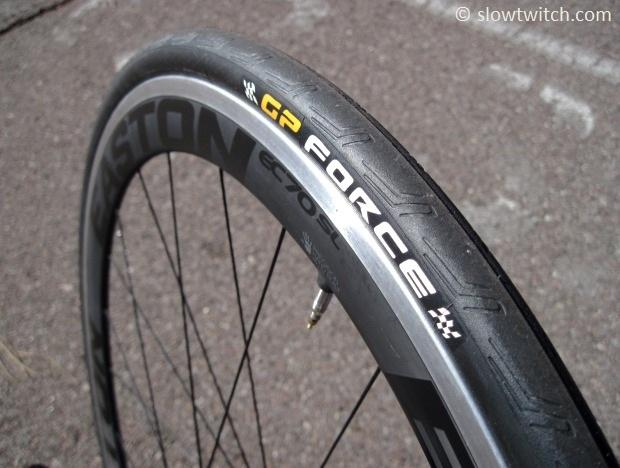
I really wanted to test the cornering prowess of these things. Lucky for me, I live very close to a large parking lot, so I set up a virtual course with parking lines and light poles.
And…? These babies corner well. Of course, I am not immune to the placebo effect. I test out a lot of equipment, and don’t always get to ‘live’ with a product for a very long time. In this case, the cornering ability felt very real to me. Other independent reviews in our user forum show similar experiences, so I doubt I’m alone in my opinion of the tires. They’re not handmade latex-tubed $150 tubular tires, and I don’t expect them to feel like they are. In my opinion, they do offer good value for the price. They ride better than average, corner great, and appear to do everything that Conti tells us.
The aerodynamic story looks to make sense, at least on paper. Time and independent tests will show us the truth. Thus far, the only rolling resistance test I’ve found for the Attack/Force was done by the German Tour Magazine, in their September 2011 issue. The Attack/Force won the lowest rolling resistance, but the competitors were admittedly mid-pack performers – no super racy tires among them (and unfortunately, no GP4000 ‘S’ to compare to).
The Conti Product Line
The only real ‘problem’ I see with the Attack and Force set is a good one to have. Continental’s road tire line is so complete and so diverse, you may wonder where the Attack/Force fits in. What is their job? Who is the customer? Indeed, I struggled to figure this all out. You have the 4000S, the 4000, Attack/Force, SS, Tri, Gatorskin, 4-Season, and on and on. Maybe they’re all the same casing. Maybe they’re not. This one has a thinner tread. That one has an extra puncture strip…
Here we see the insides of a standard GP4000:

Confused? Here’s the breakdown of your key clincher options:
Standard GP 4000 (650x23mm, 700x20mm, 700x23mm, 700x25mm): On a budget. Best of all worlds. Works well if you don’t want to change tires for race day (although I do not recommend this). Also available in a rainbow of pretty colors.
GP 4000 ‘S’ (700×23, 700x25mm): The standard 4000’s slightly racier cousin. Contains super-grippy-and-fast black chili compound. It has been reported to be one of the most aerodynamic 23mm tires out there, and is no slouch in the rolling resistance (Crr) department either, especially considering its fantastic puncture resistance. Conti sells a ton of these for a reason – they’re great tires. Some say that this tire is identical to the black-color standard 4000, but I’m not sure. Conti publishes a 10 gram weight difference between the two tires for the same 700×23 size, so for now I’m assuming they are different tires.
GP 4000 Triathlon: A 4000 with slick tread. Discontinued. No better suited for triathlon than any of the other 4000-series tires.
GP 4000 TT (700x23mm): Light; 180g. Slick center tread with roughened shoulders. This tire could be the potential sleeper in the line-up. It’s lighter and thinner than the 4000 ‘S’. It still has a Vectran breaker. Tony Martin won the Worlds TT on a prototype of this tire (or so we are told). The only thing we don’t have yet is definitive evidence showing that it is actually more aerodynamic or faster-rolling than the 4000 ‘S’.
GP Supersonic (700×20, 700x23mm): Get out your gram scale, because these things are crazy light, at 140g for the 20mm version, and 145g for the 23mm version. There is NO puncture-resistant strip of any kind; ride at your own risk. With their lightest inner tube, the complete package weighs 200g. Crr data shows good things – these are fast rollers.
GP 4000 4-Season (700×23, 700×25, 700x28mm): Take the standard 4000 and beef it up for training with a thicker tread and double Vectran breaker. Also has an added 28mm size.
Gatorskin (650×23, 700×23, 700×25, 700×28, 700x32mm): Take the 4-Season and give it a shot in the arm and a slap on the tuckus. Super thick tread, Dura Skin protection, and PolyXBreaker puncture strip. It certainly won’t ride like a race tire, but should get the job done in about any condition.
Here’s a look at the anatomy of a Gatorskin:

My take?
I’d use the Attack/Force for technical courses on a dry day. They corner great. They could potentially perform better than the 4000 ‘S’ – the front is slightly narrower (potentially more aerodynamic), and the rear is slightly wider (with potentially lower Crr, as there is more weight on the rear tire). But – we don’t really know.
I’d use the 4000 ‘S’ for courses where I’m unsure of the road conditions. Then – pick the width based on the weather forecast. Race-day downpour on rough roads? 25mm front and rear at about 90psi. Relatively smooth course, but potential for rain? 23mm front and rear at 100psi.
You can train on the standard 4000. If you want even more beef or a wider size, look to the 4-Season or Gatorskin.
For the true speed-seekers, the Supersonic is your choice. Also be prepared for an increased chance of punctures. The new 4000 TT could potentially be another middleground between the racing-only SuperSonic and the durable 4000 ‘S’ – but I’ve not tried them, and we don’t have any data to back it up just yet.
Continental Attack/Force specifications:
Weight: 190g front, 210g rear
Price: $145/pair
Manufacturer recommended pressure: 110psi
Maximum pressure: 120psi
Construction: 3 plies, 330tpi, Vectran Breaker, Black Chili Compound



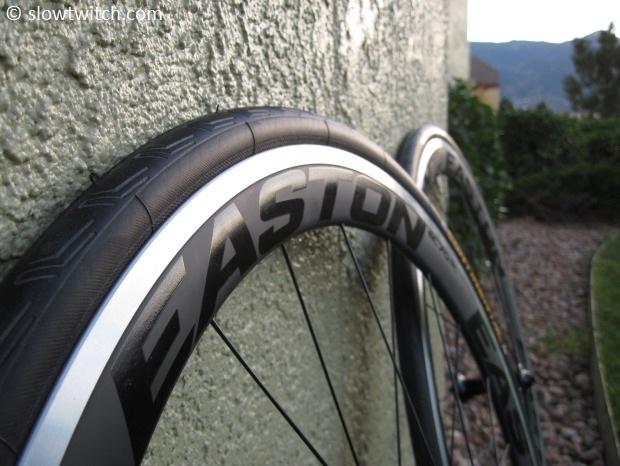

Start the discussion at slowtwitch.northend.network